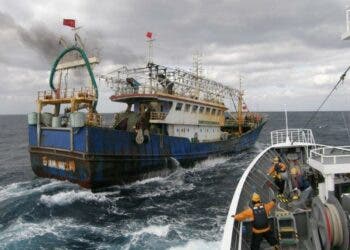The magnificent birds could help researchers pinpoint the location of illegal fishing vessels.

The world is not fishing sustainably. Across the oceans, fish stocks have shrunk and collapsed, and a recent study found that if fishing rates continue unchanged, all the world’s fisheries will collapse by the year 2048.
Illegal fishing makes up a large part of that problem. It is believed illegal and unregulated fishing account for up to 30% of total catches. The problem is, enforcing regulations is difficult. The oceans are vast and policing them has proven a gargantuan task.
The first difficult step is detecting illegal vessels. There’s just no easy way to see which vessels go where — and this is where lazy albatrosses can help.
Albatrosses are majestic birds, having the largest wingspan of any living bird: up to 3.7 m (12 ft). They scour the seas searching for fish, squid, and krill, flying up to 16,000 kilometres (9,900 mi) without landing. They’re also opportunistic, not only hunting but also scavenging when they can.
We’ve known for quite a while that albatrosses also like to follow fishing vessels around. They see this as a “free lunch” — a way to eat something without going through the effort of hunting.
This makes them ideal ocean sentinels.
In a new study, researchers show how albatrosses can be used to help monitor illegal fishing vessels. The idea is pretty simple: tag some birds with GPS trackers and radar loggers. When the loggers receive a radar signal (coming from a boat), you can see if the boat is legally registered, and if not — boom, you’ve found an illegal fishing boat. It’s a simple but very efficient idea, and the loggers are small enough that they don’t cause any real discomfort to the birds.
This was put to the test by researchers from France and New Zealand, as a part of the Ocean Sentinel program.
The researchers equipped almost 170 albatrosses with GPS loggers for 6 months, monitoring more than 47 million square kilometers of the Southern Ocean. When they looked at the data, researchers found that more than a third of the fishing vessels operating in international waters were illegal.
The method is remarkably cheap and efficient and can cover fast swaths of the ocean almost free of cost. As an added bonus, the data could also be used independently for animal conservation.
Already, similar equipment is being tested in New Zealand and Hawaii for other marine species, like sharks and sea turtles. If this technology could also be easily adapted to avoid any discomfort for the animals, this could mark a very important step in monitoring and combating illegal fishing.





